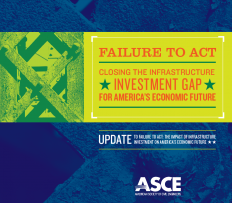The High Cost of Underinvesting in Infrastructure: $9 a day
May 10th, 2016 | By: Becky Moylan
 Today’s release of the American Society of Civil Engineers’ Failure to Act: Closing the Investment Gap for America’s Economic Future reveals that inadequate infrastructure is costing every American family $3,400 a year in disposable income.
The economic study, an update to the initial series ASCE released prior to the 2013 Report Card, identifies the 10-year needs across 10 categories of infrastructure is $3.3 trillion, including a $1.4 trillion investment gap.
The $1.4 trillion investment gap comprises:
Today’s release of the American Society of Civil Engineers’ Failure to Act: Closing the Investment Gap for America’s Economic Future reveals that inadequate infrastructure is costing every American family $3,400 a year in disposable income.
The economic study, an update to the initial series ASCE released prior to the 2013 Report Card, identifies the 10-year needs across 10 categories of infrastructure is $3.3 trillion, including a $1.4 trillion investment gap.
The $1.4 trillion investment gap comprises:
- $1.1 trillion throughout the surface transportation network including roads, bridges, transit, and commuter rail.
- Electricity infrastructure requires an additional $177 billion.
- The third highest investment gap is $105 billion for water and wastewater infrastructure.
- Airports, including the highly anticipated NextGen technology upgrade, require an added $42 billion.
- America’s inland waterways and ports need an additional $15 billion to close their funding gap.
- $3.9 trillion in GDP, more than the 2013 GDP of Germany
- $7 trillion of business sales
- 2.5 million job losses in the year 2025
- $3,400 in a family’s annual disposable income each year from 2016 to 2025, equal to $9.33 a day.
Closing America’s Infrastructure Gap
May 9th, 2016 | By: America's Infrastructure Report Card
Infrastructure is the backbone of our economy and when it’s not maintained all Americans feel the effects, but what does that look like in dollars for my family, my business and the overall economy? The American Society of Civil Engineers’ new economic study, Failure to Act: Closing the Infrastructure Investment Gap for America’s Economic Future will be released on May 10th and will highlight exactly how much America’s infrastructure investment gap is impacting the U.S. economy and household income. The report quantifies how the failure to invest in our aging infrastructure impacts the economy, including:- GDP
- jobs
- personal disposable income, and
- business sales.



 */ ?>
*/ ?>














